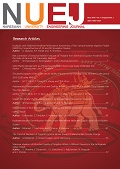Hydraulic and sediment handling performance assessment of Rani Jamara Kulariya Irrigation Project (RJKIP) by conjunctive use of 1D and 3D simulation models
Main Article Content
Abstract
The main objective of this study is to check the hydraulic capacity of designed structures and their behavior under high concentration of sediment inflow. It is also intended to check the possible changes in design without hampering the performance; to make it economic. One dimensional model HEC-RAS has been used for major portion of the study and three dimensional model SSIIM has been used in settling basin and the results are compared. The results from two models have been compared.
The result suggests that the flow capacity of system can decrease to 71 cumecs from design value of 80 cumecs when checked under minimum sustained river water level at headworks. The Particle Size Distribution (PSD) of Karnali for the month of August is taken and simulated in HEC-RAS, which shows that all particles of size greater or equal to 0.125mm are trapped in the settling basin. For intermittent flushing, the D50 of active particle downstream of settling basin is found 0.030mm whereas it is found to be 0.035mm for continuous flush with a flushing discharge of 20m3/s. Other different scenarios of operation and also some design modification in settling basin are checked in HEC-RAS. The hydraulic and sediment study has also been done for settling basin using SSIIM and flow vectors and trap efficiency are studied.

